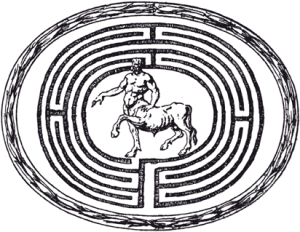
The water represents the energy, the ambrosia of eternity pouring into the field of time. The endless flowing, the continuous flowing, represents the eternal nature of this mystical dimension and also the infinite nature of its source. Since you can’t see the water’s source, that represents that it’s coming from the ground of being and also that it’s coming from another dimension which is invisible to our senses. On a deeper level there’s the paradox and the archetypal sense of the infinite coming from nothingness, which ironically enough is being postulated as the literal truth in the latest scientific origin stories such as the Big Bang theory.
Most fountains that you see spring from a round bowl-shaped container or vase. The inside of the bowl or pool is sacred space, a “Holy Grail” you might say, which represents the transcendence of duality or on a psychological level, the gap between our thoughts.
Water has long been seen as symbolic of the ambrosia of eternity—and in mythology and psychology as symbolic of the subconscious. A fountain represents a sacred opening, gap or tunnel which is a connection to eternity itself—as well as to the depths of our own being, which for all we know, (and “knowingness” or “chit” in Sanskrit is the metaphysical key to ‘riding this wave’ so to speak), is infinite, equal in its adventure and richness of experience to the “outer” world as is the Ying is to the Yang and gravity is to matter.
In a way, a kind of mini temple, yet completely natural: a religious, mystical experience paradoxically combining both the mystical and the physical, representing a connection created by nature herself.
This is why it evokes an archetypal response of beauty in most people: The aesthetic being, at least on the symbolic level, the manifestation of a mystery.
02/09/16 Update: One element that struck me recently, especially looking at the still photograph, is the Lingam/Yoni symbolism. And there is a strong dichotomy of the Lingam, representing Shiva, coming out of the bowl/vase shaped Yoni, which is representative of the feminine aspect. But if you think about it from a Hindu perspective this makes total sense: The “Void” out of which everything comes and back into which everything goes is the Mother Goddess of the Universe. She is it. Symbolically speaking, the divine feminine represents life itself, and the Lingam, the male divine, represents the snake, who by piercing life, right through the middle, throws off death, just a snake throws off its skin.
The fact that the Lingam and Yoni are seen as together, like the Ying and Yang of Asia, as well as the water and bowl of a fountain, represents that the two are one, that the feminine and masculine are merely two different aspects of the same thing, just like the eternal and the imminent, the mysterious and the manifest, and indeed, life and death: this represents to the soul the transcendent nature of its own being.
Read this quote by Joseph Campbell
“Nevertheless-and here is a great key to the understanding of myth and symbol-the two kingdoms are actually one. The realm of the gods is a forgotten dimension of the world we know. And the exploration of that dimension, either willingly or unwillingly, is the whole sense of the deed of the hero.” – The Hero with a Thousand Faces, page 217, The Crossing of the Return Threshold
Here, the “realm of the gods” is symbolized by the Yoni, the void, the bowl, the feminine. And the “world we know” is represented by the Lingam/Masculine aspect. The masculine is representative of manifestation, but that manifestation has the potentiality to come in contact with the divine, indeed become divine, if it has the energy, drive, and intent to summon itself into one direction, namely that of the spontaneity residing inside the bowl of its own heart.
Another dichotomy: Notice in the fountain and in Hindu temples, the Lingam aspect is coming out of the Yoni, not going in: That’s symbolic of a resurrection. New life (Nova Vita) in this case not coming from sexual intercourse, but from a birth of the heart.
Update 9/12/21 — These graduates seem to be popping out of the water just like the fountainhead itself—as if the fountainhead were a person too, or as if the two guys were, and their being and consciousness, types of fountainheads. The fountainhead represents a being, a connection between the two worlds, not as refinedly formed as his two ‘brothers’ are in this photo, but more in touch with the primitive, indigenous, fundamental energy and ground of being which is it source. Even beyond that a water fountain is a symbol, like a church, of a connection to the eternal world (which paradoxically is both natural and metaphysical) you’ve got a symbol of the two ‘more evolved’ creatures re-communing with the more primitive yet ultimate source of their life. It’s thus symbolic that education in this sense is as much as an inward exploration and pulling out your innate wisdom as it is absorbing, learning from, and incorporating outward stimuli (the fountain of life is in you as much as it is outside you). The ultimate symbol is that the lines of communication between the two worlds must not only remain open but continue to get richer (‘the falcon cannot hear the falconer’) in order for experience and ultimate fulfillment to keep expanding.
What is it in us that responds spontaneously to the elemental forces? Especially in the younger folk who have a much more alive connection? Fire is the “water” of the underworld, the “water” of night, the “water” of the depths of our subconscious that illuminates revelations that come from within. Most things you divide them, they become smaller. Just like the Gods, the more you divide fire, the bigger it becomes, the more it becomes…
“If you bring forth what is within you, what you bring forth will save you. If you do not bring forth what is within you, what you do not bring forth will destroy you.”
The Gospel of Thomas #70

